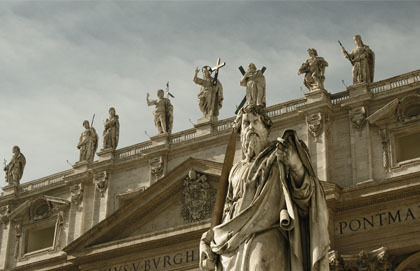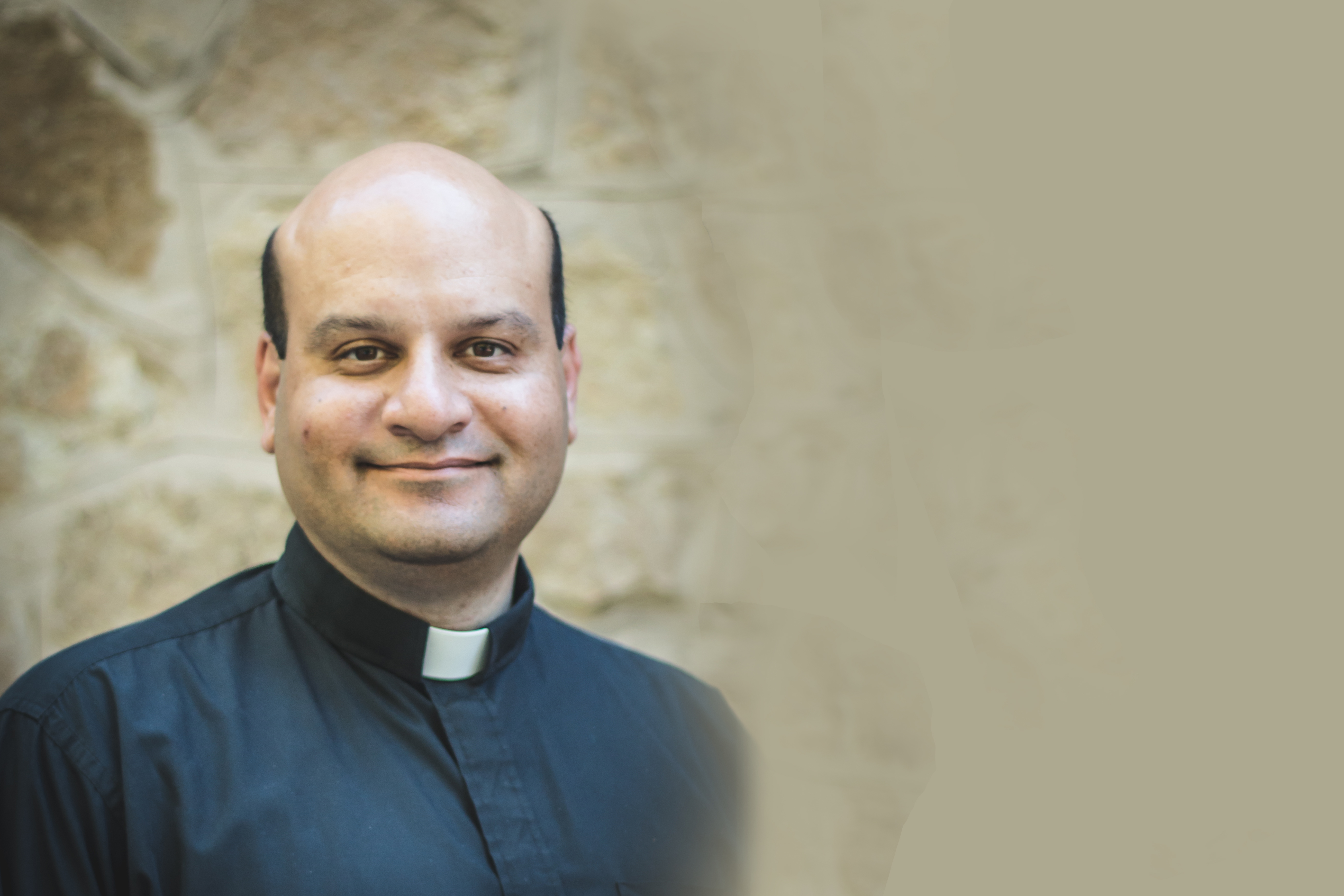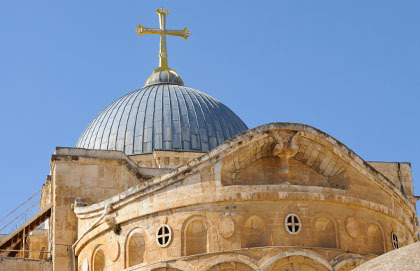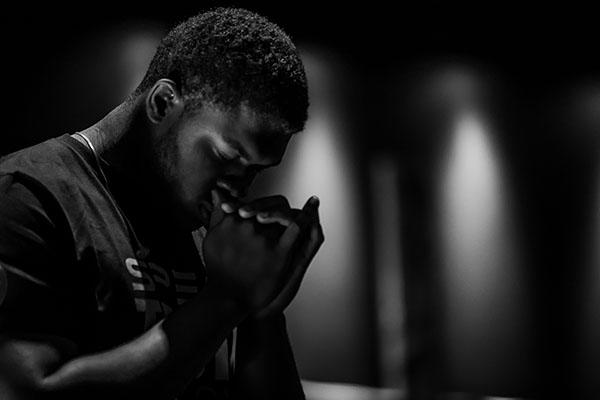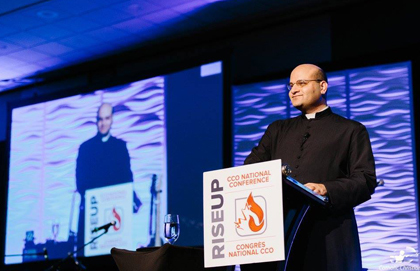With 2013 about to dawn, and Convivium celebrating its first birthday, editor-in-chief Father Raymond J. de Souza addressed a gathering of supporters and members at Loyola High School in Montreal. He spoke to those assembled about five anniversaries, from the birth of religious freedom in Constantine's Rome to the nation-building meaning of the greatest goal ever scored in Canadian hockey. The following text is adapted from that talk.
We launched Convivium in 2011, and in 2012 completed our first full year. That's not a small matter in the world of publishing, so while a first anniversary is by definition only a beginning, it bears noting, too.
Significant anniversaries accompanied us throughout 2012. Almost every month there was one or another being marked. Consider: 1,700 years since Constantine I won the Battle of the Milvian Bridge; 500 years since Michelangelo completed the frescoes on the Sistine Chapel ceiling; 200 years since the War of 1812 began; the Diamond Jubilee of Queen Elizabeth II; 50 years since the Cuban Missile Crisis and the opening of the Second Vatican Council; 40 years since the Summit Series between the Soviet Union and Canada, in which Paul Henderson scored the winning goal; 30 years since the Canadian constitution was patriated; 10 years since World Youth Day in Toronto, the largest religious event in Canadian history.
Much of these provided material for our pages, touching as they did on the place of faith in our common life. Indeed, looking back at some of these anniversaries provides us with a survey of the place of faith in our common life, and thus a glimpse of what we are trying to do at Convivium.
Looking Toward Heaven: Constantine Wins at the Milvian Bridge
In October, we marked the 1,700th anniversary of the victory of Constantine I at the Milvian Bridge, by which he became emperor of the united Roman Empire. Constantine came down from the north, conquering various territories before arriving in Rome, where the ruling emperor was Maxentius.
The night before the Battle of the Milvian Bridge in October 312, Constantine had a vision—a Christian vision. He was not a Christian, but his mother, Helena, was a very devout Christian, so he would have known Christianity well. Some historians estimate that as much as half of the population of Rome may have been Christian at that point. By 312, Christianity was not an obscure thing. It was, though, a persecuted thing.
Nevertheless, the night before the battle, Constantine looked up and had a vision either of a cross or the Chi-Rho, the Greek monogram for the name of Christ. He saw a Christian symbol and the words "in this sign [you shall] conquer." The next day he went into battle and won. He arrived as the conquering emperor in Rome, yet he did not make the usual offerings to the pagan gods. He credited his victory to the Christian God.
The new emperor, therefore, legalized Christianity first, and eventually lavished the patronage of the empire upon it, which was very advantageous at that time. Constantine died as a baptized Christian, having established Christianity as the favoured religion of the empire yet without suppressing other religions. The Battle at the Milvian Bridge is not a biblical event and does not belong to God's revelation of His salvific plan. Yet it remains one of the most important dates in the history of Christianity.
There are a few lessons we can take from that battle and its aftermath. Whatever the supernatural character of Constantine's vision, he had a choice. There were other religions in Rome, yet Constantine chose to ally himself with a previously persecuted one. Constantine's choice is a reminder that choices shape history rather than an impersonal history shaping the choices of free men. One man's choice can be a great turning point in the lives of men, even nations, or the world. That is a deeply Christian idea, one that has freed men from being beholden to fate or the arbitrary will of the many gods.
For the Christian Church, Constantine's victory meant an end to a prolonged period of persecution. Under Roman rule, there were times of relative religious tolerance for Christians, but there were also periods of intense Christian persecution, beginning with Nero's persecution in 64-68 AD, in which the apostles Peter and Paul were martyred. The last great Christian persecution was in 305. Roman persecutions were brutal things, as one would expect from the empire that perfected the art of crucifixion.
That was the experience of Christianity for nearly three centuries, which despite being a time of heroic witness meant that it was very difficult for the Church to live her proper life. Liturgical, theological, doctrinal and catechetical development, to say nothing of Christian works of charity, were severely impeded. It could be done, though, and it was done. There were martyrs aplenty. But that period of intense persecution came to an end, at least in the Roman Empire, with Constantine's victory.
There is a lesson for today, because persecution continues. There are Christians who are persecuted for their faith, and some in very brutal fashion. So it's a reminder to us that persecution is part of the life of the Church. Sometimes Christians must survive it, but we wish it to end. We should not romanticize martyrdom. It is an inescapable dimension of the Church's life, but it also impedes the normal life of the Church. The Church began to live in a normal fashion after Constantine.
Two other developments were critical in reconfiguring the place of the Christian Church in public life.
We can presume that Constantine was of good will and integrity in embracing the Christian faith. Let's presume he did so because he thought it was true, and for that reason he was baptized. It still remains that there was something about Christianity that appealed to Constantine as a secular ruler, as an emperor. It was Christianity's universalism—one God for all the people. We are accustomed to that idea now, 17 centuries after Constantine; but in the history of religion, it was more often the case that the god or gods were local. These people have this god; those people have that god. Or maybe one culture might have one god for the harvest, a god for the winter, a god for rains, a god for war, a god for tides, a god for the flood, a god for fertility, and so on. So gods were localized. The great mission of the Jewish people was to proclaim that there was only one God, a novelty in the ancient world.
If you are running an empire, with all kinds of different people under your rule—geographically dispersed, culturally and linguistically diverse—one way to unite them is to have a common cult, a common worship. Religion could be a source of unity and peace between different peoples in the same empire. Aside from personal piety, then, a universal religion had political advantages for the empire. Constantine saw that Christianity offered in its universalism something that was attractive to a multinational empire. That is an important lesson for today. Religion as a common profession of faith can be a force of unity between disparate peoples.
Canada is becoming more diverse because we have immigrants from all parts of the world. Therefore, to accommodate this diversity, it is often argued that we cannot be as Christian, or as religious. In point of fact, though, it is often the case that one of the things that might unite immigrants with Canadian society is precisely their religious faith. It might be fellow believers who welcome them and with whom they develop the friendships they need to succeed in Canada. Someone from Cameroon may not be very familiar with Canadian culture but might feel readily at home in a local church where the worship is familiar. So whether in Constantine's time or ours, there is a social utility of a religion with universal reach.
Also of importance to the history of Church and State relations was Constantine's decision in 325 to call the first ecumenical council of the Church—the First Council of Nicaea. There was a dispute in the Church about the nature of Jesus Christ. Was He indeed God from God, Light from Light, True God from True God as the Nicene fathers would eventually profess? Or was he something less than that? Before Constantine, because Christianity had been underground, it was hard to get everyone together to decide theological questions properly. Just seven years before the Milvian Bridge, there was a great persecution. Gathering everyone together for a council was not only difficult, it could also have been deadly.
The dispute was called the Arian controversy, and Constantine wanted to resolve it, partly for reasons of statecraft. He did not want divisions in the faith being proposed; he wanted unity. So he called the First Council of Nicaea. The bishops of the Church met in what is now Iznik in modernday Turkey. Constantine did not resolve the controversy himself, though as emperor he was likely tempted to do so. He desired a resolution, but that resolution was not his to make. He asked the bishops to do it. He summoned them, but they were the ones who made the decision. Constantine was an absolute ruler, an emperor whose imperial predecessors considered themselves quasi-divine.
In calling the Council of Nicaea, he acknowledged a limit to the power of the Crown, of the State. Doctrinal matters were not his competence. The Church would have said from the beginning that Caesar did not have the competence to make doctrinal decisions. But it was a landmark event for the emperor to recognize that himself. In 305, the emperor was killing Christians. Twenty years later, Constantine recognized that the things of God are His own. At Nicaea, there was recognition not from the Church but from the imperial power of its own limitations in matters of doctrine. Though the term "religious liberty" was not used then, Constantine's reign marked a critical historical development in the State recognizing the freedom of the Church. Both religious liberty and the freedom of the Church are at issue in every generation. The imperial power—or the modern State—does not always give the answer given in 325. Yet that principle, established in the 4th century, was certainly advantageous to the growth of Christianity and the purity of the life of the Church.
Looking into Heaven: Michelangelo and the Ceiling of the Sistine Chapel
The second anniversary I propose to examine requires a leap ahead 1,200 years to 1512. On October 31 of that year, the vigil of the feast of All Saints, Pope Julius II went to the Sistine Chapel to dedicate the ceiling frescoes of Michelangelo, a commission he had forced on the Florentine sculptor four years earlier.
Rome in 1512 looked much different than in 312. It is a worldly papacy, which gives us pause. Part of that worldliness is wealth channelled toward patronage of the arts, which constitutes a genuine witness to the Christian faith. It is astonishing to think of all the artists who worked under papal patronage between 1450 and 1550. Michelangelo was the greatest of them all, and he painted the ceiling frescoes of the Sistine Chapel from 1508 to 1512, returning decades later to paint The Last Judgment on the altar wall.
This is no longer about Church and State in conflict. The Church does not have to insist upon limits to State power. Here we have ecclesial power instead, a highly ambiguous state of affairs. As a civil power, the Church must provide for the common good, including the arts. In the Sistine Chapel adornment, that was accomplished in spectacular fashion. Five hundred years later, there are thousands of people—sometimes as many as 20,000—who enter the Sistine Chapel every day to look up into Heaven as Michelangelo depicted it.
This enormous river of humanity from every nation and every place includes people with great aesthetic sense, people with no aesthetic sense, people of great religious devotion and theological sophistication, and people who don't even know who is on the ceiling. All are included in the great flood of people who come every day to look at Michelangelo's work. Nowhere else do so many come to look at a single work of art. And when they come, they see Michelangelo telling them about creation, fall and judgment, redemption and salvation. They see the Christian story of the world in fresco. The Sistine Chapel is the Church serving the common life of all, including those who are distant from the things of God.
Cardinal Ratzinger, before his election as pope, once said that in the end the Church has only two compelling "arguments" for her faith being true. Only two things really testify persuasively to the credibility of the faith, to its believability. The first is the saints who have lived the gospel fully and who the Church proposes as models of Christian witness. The second is the art that she has nurtured in her midst, her faith expressed in beauty, whether in painting, sculpture, architecture or music.
The Church's faith provides this gift of beauty to the world. We do not live in a very beautiful world. Today is not 16th century Rome in terms of our public artists. To our world, the Church continues to offer from her patrimony the service of beauty. The Church offers to our common life that which is beautiful. Not just art, but beautiful lives—the lives of saintly people from every time and place. The Church in our common life, the role of faith in our common life, is to give us reason to look up, to raise the eyes of a disenchanted culture above the daily grime to that which is beautiful. That is the role of the Christian in ugly times: to make present that which is beautiful. Like the biblical steward, we bring out our treasures old and new, beauty from our history and from our current circumstance.
The Diamond Jubilee
The third anniversary that I propose has something to teach us is not a religious anniversary—or maybe it is in part. The Diamond Jubilee of Her Majesty the Queen occasioned a lovely article by Hugh Segal in our March issue, our premiere issue. The Queen is our head of state, but she is also head of the Church of England, and understands her queenly role as the sacred duty of a Christian disciple.
There is a long tradition of Christian kingship and the responsibilities of the sovereign to the common good of its people, including their spiritual welfare. Moreover, the incarnational intuition of the Christian faithful has sympathy with the personification in a monarch of a people and their history. Even if the king should be wicked, the principle and the ideal can still hold, even in vestigial form, like the Canadian Crown.
When I was studying in Rome, in a seminary where I lived mostly with Americans, I had a picture on my desk of Her Majesty Queen Elizabeth with Pope John Paul II. It was taken during her Jubilee visit in the year 2000. My American friends would come by and make jokes as Americans do about our Queen. It became tedious after a time, but I only found a way to put an end to it when I explained one day: "Well, she is the Queen of Canada, our head of state. So I have on my desk our head of state with the Holy Father. Where are your pictures of your head of state with the Holy Father?"
At that time, President Clinton was in office, and there were no pictures of President Clinton, with or without the Pope, to be found on seminary desks. I doubt that many are desirous of having George W. Bush or Barack Obama on their desks either.
Queen Elizabeth marks 60 years of an admirable reign. Here we see a different aspect of the relation of the Church and State because the Crown, our Crown, the Crown of Canada, is not only the State personified, but also the head of an established Church. The head of state is also titular head of the Church of England.
In November, the General Synod of the Church of England voted on the question of ordaining women as bishops. The large majority of delegates were in favour, but in the tricameral structure of the Synod, it did not pass. Leaving aside the merits of the question, this caused a bit of an uproar. So there was a debate in Parliament. Various MPs delivered their views on what the Church of England should or should not do. Prime Minister David Cameron addressed the question with admirable theological precision: "The Church has to get with the program."
We are a long way from Constantine. "Get with the program" is not exactly "God from God, Light from Light...," but it is admirably blunt. The Church has to get with the program. Even in its cavalier expression, it betrayed a certain ignorance of the history of these questions in the British Isles. Getting with the program has been the issue in Crown and State conflicts going back to Thomas Becket, Thomas More, John Fisher and other English martyrs. The Prime Minister's remark betrayed a certain lack of gravitas.
Which program should the Church get with? That has been the subject of a longstanding debate within the Anglican Church. The idea that the prime minister or Parliament would be determining that standard is certainly a reversal from the orthodox Christian conception of things. Yet in his response to the General Synod, the Archbishop of Canterbury seemed rather sympathetic to the inelegant phrasing of the Prime Minister.
"We have a lot of explaining to do," Dr. Rowan Williams said.
That is an interesting thing for a Christian pastor to say. Explain what? To whom? In one sense, to say the Church has a lot of explaining to do is to say what it means to be an evangelist. There is nothing wrong with the Church explaining what she believes or whom she believes in. That is her mission. It's a question of which program and by which standard the explanation is to be given. Is the secular consensus the standard against which the Christian gospel is measured and found wanting? Or is the gospel the standard by which the secular consensus is challenged? That's an ancient question; it's a perennial question. In the Diamond Jubilee year of the Queen, where her virtues are most admired and much commented upon, this issue comes to the fore. Does the Church, in this case an established Church, have to adjust its life to the standard of the prevailing culture? That question applies to churches that aren't established, too.
From Magna Carta to the Charter
At the midpoint of Her Majesty's reign, she came to Canada to sign our new constitution. Our constitution goes back much further than 1982, but patriation was achieved that year, and so we marked the 30th anniversary of the Charter of Rights and Freedoms in 2012. Patriating the constitution has had a massive effect on our common life together and how we resolve disputes. The charter has meant that, for 30 years now, we increasingly turn to the courts to resolve disagreements about social and legal reform.
Our Canadian Charter stands in a long line that goes back to the original charter—the Magna Carta of 1215, the first of the great charters that limit the power of the Crown against the individual. The first freedom listed in the Magna Carta is the freedom of the English Church. Again, they would not then have called it religious liberty as we call it today. But it's analogous if not exactly the same. The American Bill of Rights has as its first amendment the free exercise of religion. Freedom of conscience and religion are the first of our Charter freedoms. This is not accidental.
If the State does not recognize religious liberty, there are no other liberties that it must recognize. If the State does not have to recognize the citizen's own conscience and obligations toward God, then everything else is up for grabs.
That has been affirmed in our Charter for 30 years now, and we have embraced a Charter culture with an exaltation of the individual as an autonomous source of rights. This is in tension with the traditional Christian idea of rights that are rooted not in our autonomous individualism, that is, the autonomous self, but that our Creator endows in us. To use the more ancient biblical language, we are made in the image and likeness of God and therefore have certain rights.
We have seen 30 years of Charter jurisprudence where this Christian idea has been overtaken by the philosophy of autonomous individualism. But individuals who are asserting their rights can often find that their rights conflict with one another. In fact, you can even arrive at a point where fundamental rights, including religious liberty, can be seen as a threat to other rights. Religious liberty can be seen as a threat to the common good and even to the rights of individuals. Court decisions in 2012 demonstrated that in two Quebec cases—the idea of religion as a threat to the common good animates public policy to a considerable degree. Our Charter culture is one that, despite its first freedom, can actually have a deleterious effect on the role of religion in our common life. The Charter anniversary is a sombre one from the point of view of the contribution of faith to our common life.
Henderson Scores for Canada
Constantine, Michelangelo, the Queen, the constitution—all important to be sure. But as important as Canadian hockey supremacy? To be fair, the 2012 anniversary that generated the most enthusiasm was that of the Canada-Soviet Summit Series in September 1972. It's been 40 years since Foster Hewitt broadcast to a waiting nation that "Henderson has scored for Canada!"
Such moments of intense communal experience are essential in the formation of a common life. Canadian common life depends in part on hockey and the signal moments in our hockey history. There is another lesson in the Henderson goal though. Having scored the most famous goal in Canadian hockey, Paul Henderson has been celebrated for his timely achievement for four decades. And for almost four decades, Henderson has been a committed Christian evangelist, not shy about sharing his faith. The fact that most Canadians don't know this about Henderson is one reason we started Convivium, and why we were delighted to feature an interview with Henderson in our last issue.
We're at the end of our first year. We've had a very favourable response, it's fair to say. Alas, it has not been unanimous. We have our critics. But even our critics recognize that we are trying to do something of interest in exploring faith in our common life. A first anniversary should not be exaggerated, but it is also necessary on the way to other, we trust, more significant anniversaries to come.


